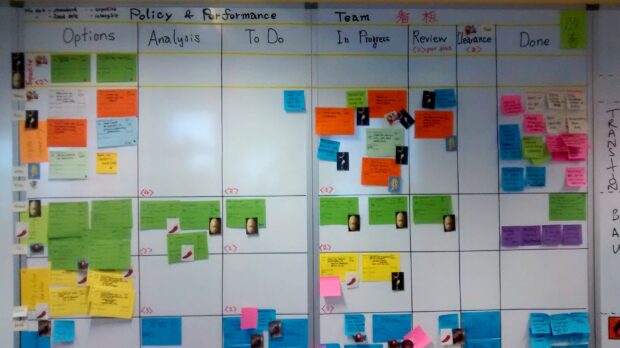https://mojdigital.blog.gov.uk/digital-capability-embedding-digital-styles-of-working-in-moj/
Digital capability: embedding digital styles of working in MOJ
[The Civil Service] needs to become Digital by Default, in its skills, its style, how it communicates and how it enables service users to interact with it… a mindset that revolves around the user, not the producer.
Civil Service Reform Plan
What is digital capability?
What springs to mind when someone says ‘digital capability’? MOJ Digital did some asking around, and heard things along the lines of: mandated and clunky IT systems, building websites and coding, even just social media tools such as Twitter.
No, not quite.
‘Digital’ is an umbrella term. It’s about having an innovative mindset and a fast-paced, user-focused style of working. It’s called ‘digital’ because it borrows tools and techniques from software development, but which are equally applicable to policy-making and operational delivery.
We’ve come up with 5 principles of digital capability, listed below.
5 principles of digital capability
- Put user needs ahead of process
- Start small, and improve from there
- Make the most of digital tools
- Manage risk, don’t be blocked by it
- Feel empowered to innovate
1. Put user needs ahead of process
At the end of the day, government policy is about serving the public. Whether the end user is a member of the public, a stakeholder in government, or business counterparts, understanding the person at the end point of the programme of work is fundamental to the way we work.
This means moving beyond consultations with poor response rates, and strategy documents developed in conjunction with numerous stakeholders who are prioritised above the end user. It’s about learning qualitative user research techniques, such as persona creation and journey mapping, that make interacting with the public a useful and fruitful endeavour.
https://www.youtube.com/watch?v=oETvGGA5Kr4&list=UUn2dwNeWhDIPOvcRVQiOmtA
2. Start small, and improve from there
Traditional project management and policy development has involved numerous stages that can last months, if not years. Too often, large-scale pilots or long-term process planning have meant efforts are unable to be refined or end up abandoned.
Yet the most effective way of working at a task, any task, is to break it up into small, manageable pieces, and then work in a short – perhaps week-long – burst to deliver a result. Quick feedback to inform the next burst then allows work to be refined as you go along.
Working quickly with constant feedback and iteration – known as agile – means you can test, improve, and/or discard options in a safe environment. It means you can constantly monitor progress in real time, allowing for an end result most in tune with those it impacts.
3. Make the most of digital tools
Say goodbye to confusing version control, endless spreadsheet collating and constant paper pushing. The many tools that are starting to be made available in the office mean your experience of tools and technology at work can now be as good as what you’re used to at home.
Whether you’re trying to improve engagement, stakeholder management, collaboration or delivery, seeking out new tools and adapting them to meet your team’s specific needs lets you do things faster and better.
For more details, see our open internet tools guidance.
4. Manage risk, don’t be blocked by it
A confident and proportional approach to risk is fundamental to enabling innovation to occur. Digital tools and ways of working do not ignore risk, but can increase the ability to manage it. For example, small scale iterations and testing with users mean risks can be considered at every step in the project. This allows for greater understanding of any unforeseen consequences, and constrains them in a safe environment.
Perceived risk should not be an automatic obstacle to any action or change. Risks need to be approached with an open mind so a proportional course of action can be taken.
5. Feel empowered to innovate.
Perception of leadership attitudes is a vital part of accepting and embracing digital tools or techniques. Believing that you can’t cause positive change, or that you must seek permission from layers of management before giving a small improvement a go, can be stifling and lets good ideas go to waste.
Innovation requires co-creation. Senior leaders need to show clearly that they value bottom-up suggestions, and make staff feel they can trial new ways of working on their own initiative.
Please note that these principles are in alpha, and so all feedback is welcome. This page will be amended as we develop case studies for how the principles play out in practice.

